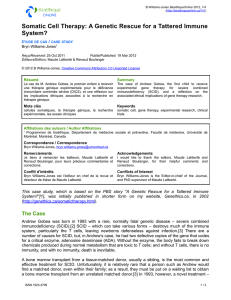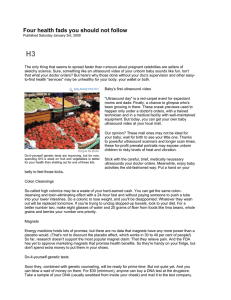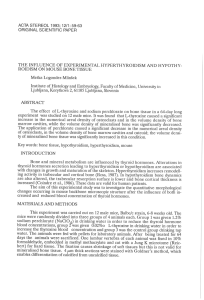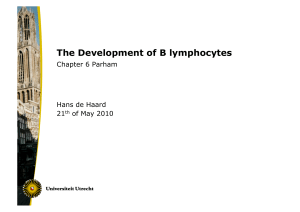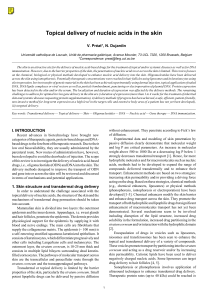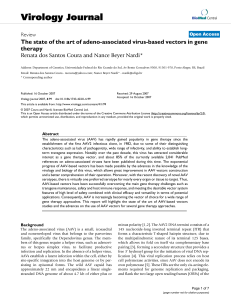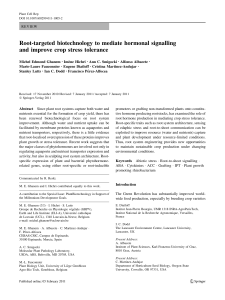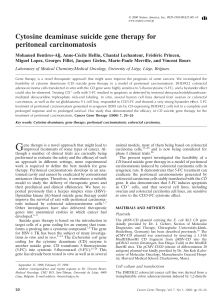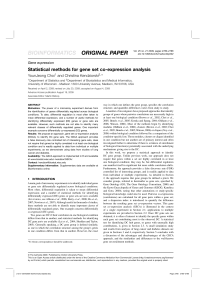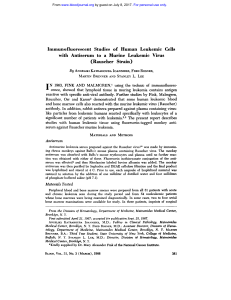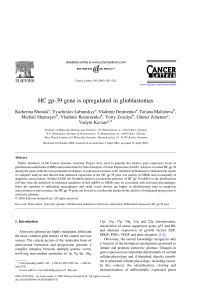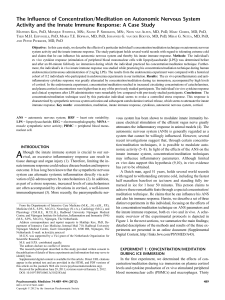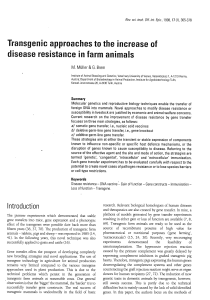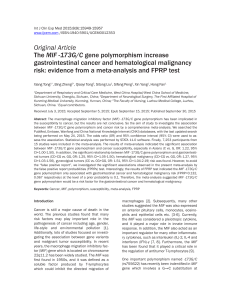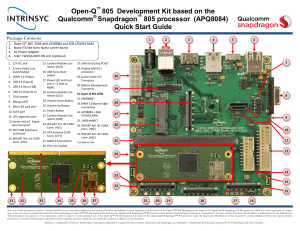TFG facundoramosochoa
publicité
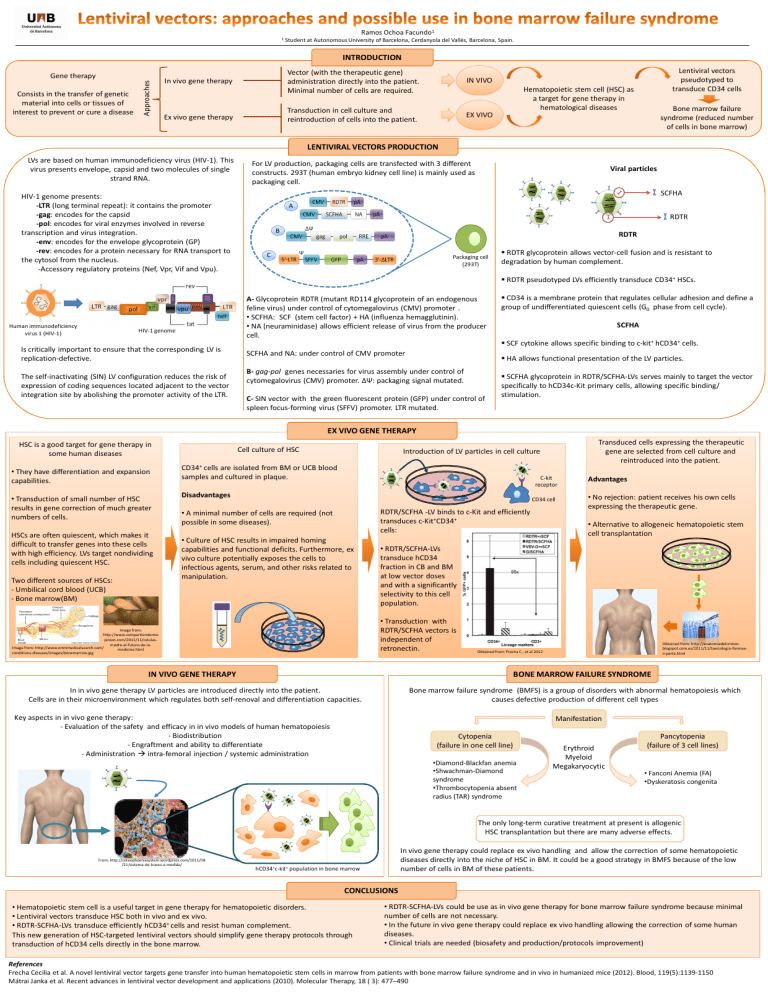
Ramos Ochoa Facundo1 1 Student at Autonomous University of Barcelona, Cerdanyola del Vallès, Barcelona, Spain. INTRODUCTION Consists in the transfer of genetic material into cells or tissues of interest to prevent or cure a disease Approaches Gene therapy In vivo gene therapy Ex vivo gene therapy Vector (with the therapeutic gene) administration directly into the patient. Minimal number of cells are required. IN VIVO Transduction in cell culture and reintroduction of cells into the patient. EX VIVO Lentiviral vectors pseudotyped to transduce CD34 cells Hematopoietic stem cell (HSC) as a target for gene therapy in hematological diseases Bone marrow failure syndrome (reduced number of cells in bone marrow) LENTIVIRAL VECTORS PRODUCTION LVs are based on human immunodeficiency virus (HIV-1). This virus presents envelope, capsid and two molecules of single strand RNA. HIV-1 genome presents: -LTR (long terminal repeat): it contains the promoter -gag: encodes for the capsid -pol: encodes for viral enzymes involved in reverse transcription and virus integration. -env: encodes for the envelope glycoprotein (GP) -rev: encodes for a protein necessary for RNA transport to the cytosol from the nucleus. -Accessory regulatory proteins (Nef, Vpr, Vif and Vpu). For LV production, packaging cells are transfected with 3 different constructs. 293T (human embryo kidney cell line) is mainly used as packaging cell. Viral particles SCFHA A RDTR B RDTR C Packaging cell (293T) RDTR glycoprotein allows vector-cell fusion and is resistant to degradation by human complement. RDTR pseudotyped LVs efficiently transduce CD34+ HSCs. Human immunodeficiency virus 1 (HIV-1) A- Glycoprotein RDTR (mutant RD114 glycoprotein of an endogenous feline virus) under control of cytomegalovirus (CMV) promoter . • SCFHA: SCF (stem cell factor) + HA (influenza hemagglutinin). • NA (neuraminidase) allows efficient release of virus from the producer cell. HIV-1 genome Is critically important to ensure that the corresponding LV is replication-defective. The self-inactivating (SIN) LV configuration reduces the risk of expression of coding sequences located adjacent to the vector integration site by abolishing the promoter activity of the LTR. CD34 is a membrane protein that regulates cellular adhesion and define a group of undifferentiated quiescent cells (G0 phase from cell cycle). SCFHA SCF cytokine allows specific binding to c-kit+ hCD34+ cells. SCFHA and NA: under control of CMV promoter HA allows functional presentation of the LV particles. B- gag-pol genes necessaries for virus assembly under control of cytomegalovirus (CMV) promoter. ΔѰ: packaging signal mutated. C- SIN vector with the green fluorescent protein (GFP) under control of spleen focus-forming virus (SFFV) promoter. LTR mutated. SCFHA glycoprotein in RDTR/SCFHA-LVs serves mainly to target the vector specifically to hCD34c-Kit primary cells, allowing specific binding/ stimulation. EX VIVO GENE THERAPY HSC is a good target for gene therapy in some human diseases • They have differentiation and expansion capabilities. • Transduction of small number of HSC results in gene correction of much greater numbers of cells. HSCs are often quiescent, which makes it difficult to transfer genes into these cells with high efficiency. LVs target nondividing cells including quiescent HSC. Two different sources of HSCs: - Umbilical cord blood (UCB) - Bone marrow(BM) Cell culture of HSC Transduced cells expressing the therapeutic gene are selected from cell culture and reintroduced into the patient. Introduction of LV particles in cell culture CD34+ cells are isolated from BM or UCB blood samples and cultured in plaque. C-kit receptor Disadvantages CD34 cell RDTR/SCFHA -LV binds to c-Kit and efficiently transduces c-Kit+CD34+ cells: • A minimal number of cells are required (not possible in some diseases). • Culture of HSC results in impaired homing capabilities and functional deficits. Furthermore, ex vivo culture potentially exposes the cells to infectious agents, serum, and other risks related to manipulation. • No rejection: patient receives his own cells expressing the therapeutic gene. • Alternative to allogeneic hematopoietic stem cell transplantation • RDTR/SCFHA-LVs transduce hCD34 fraction in CB and BM at low vector doses and with a significantly selectivity to this cell population. • Transduction with RDTR/SCFHA vectors is independent of retronectin. Image from: http://www.compartiendomio pinion.com/2011/11/celulasmadre-el-futuro-de-laImage from: http://www.omnimedicalsearch.com/ medicina.html conditions-diseases/images/bonemarrow.jpg Advantages Obtained from: http://anatomiadelcrimen. blogspot.com.es/2011/11/toxicologia-forenseii-parte.html Obtained from: Frecha C., et al 2012 IN VIVO GENE THERAPY BONE MARROW FAILURE SYNDROME In in vivo gene therapy LV particles are introduced directly into the patient. Cells are in their microenvironment which regulates both self-renoval and differentiation capacities. Bone marrow failure syndrome (BMFS) is a group of disorders with abnormal hematopoiesis which causes defective production of different cell types Key aspects in in vivo gene therapy: - Evaluation of the safety and efficacy in in vivo models of human hematopoiesis - Biodistribution - Engraftment and ability to differentiate - Administration intra-femoral injection / systemic administration Manifestation Cytopenia (failure in one cell line) •Diamond-Blackfan anemia •Shwachman-Diamond syndrome •Thrombocytopenia absent radius (TAR) syndrome Erythroid Myeloid Megakaryocytic Pancytopenia (failure of 3 cell lines) • Fanconi Anemia (FA) •Dyskeratosis congenita The only long-term curative treatment at present is allogenic HSC transplantation but there are many adverse effects. From: http://osteophoenixsystem.wordpress.com/2011/08 /21/sistema-de-hueso-a-medida/ In vivo gene therapy could replace ex vivo handling and allow the correction of some hematopoietic diseases directly into the niche of HSC in BM. It could be a good strategy in BMFS because of the low number of cells in BM of these patients. hCD34+c-kit+ population in bone marrow CONCLUSIONS • Hematopoietic stem cell is a useful target in gene therapy for hematopoietic disorders. • Lentiviral vectors transduce HSC both in vivo and ex vivo. • RDTR-SCFHA-LVs transduce efficiently hCD34+ cells and resist human complement. This new generation of HSC-targeted lentiviral vectors should simplify gene therapy protocols through transduction of hCD34 cells directly in the bone marrow. • RDTR-SCFHA-LVs could be use as in vivo gene therapy for bone marrow failure syndrome because minimal number of cells are not necessary. • In the future in vivo gene therapy could replace ex vivo handling allowing the correction of some human diseases. • Clinical trials are needed (biosafety and production/protocols improvement) References Frecha Cecilia et al. A novel lentiviral vector targets gene transfer into human hematopoietic stem cells in marrow from patients with bone marrow failure syndrome and in vivo in humanized mice (2012). Blood, 119(5):1139-1150 Mátrai Janka et al. Recent advances in lentiviral vector development and applications (2010). Molecular Therapy, 18 ( 3): 477–490






